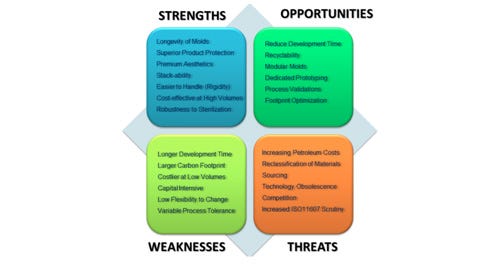Assessing potential opportunities and threats—as well as strengths and weaknesses—can help medical packaging engineers make more strategic decisions.
June 30, 2014
Assessing potential opportunities and threats—as well as strengths and weaknesses—can help medical packaging engineers make more strategic decisions.
By Abhishek Gautam
It is a common decision-making approach to accept or reject a specific material, design, or technology based upon its advantages (or strengths) and/or disadvantages (weaknesses) in package engineering. But such decisions may often be made without considering opportunities that could establish competitive advantage or threats that could present business risks. As such, the use of SWOT analysis in packaging engineering could allow for more informed decision making around materials, technologies, and services.
SWOT, a routinely used method of analysis in the business world, can be oversimplified and stated as the following:
Strengths: What is it good for? (traditional advantages)
Weaknesses: What is it not good for or what are the drawbacks? (traditional disadvantages)
Opportunities: How can I optimally use it?
Threats: What risks are there if I use it?
To build a practical perspective within packaging engineering, let’s consider a widely used packaging technology such as vacuum thermoforming. Figure 1 demonstrates common strengths and weaknesses of vacuum forming.

Figure 1
Certain individuals may consider opportunities and threats as part of assessing the strengths and weaknesses. However, it is important to maintain four separate categories—not only to facilitate a structured holistic approach for performing the analysis, but also to seek mid- to long-term translation objectives that can sustain the benefits of choices made. The translation objectives, in this instance, are the opportunities and threats pertaining to the decision at hand. Opportunities and threats can potentially be renewed as strengths to support long-term business harmonization and alignment strategies.
In a traditional SWOT model, from the viewpoint of an organization, strengths and weaknesses are often internal factors while opportunities and threats often represent external factors. In the medical device packaging industry, however, efforts toward deciding on a novel packaging material, design, or technology are usually part of a shared value vision between medical device manufacturers and suppliers. As such, we can generally consider opportunities and threats to be a mix of internal and external factors.
The full SWOT analysis for vacuum-forming technology shown in Figure 2 illustrates a more complete picture and pinpoints several such scenarios.

Figure 2
If a company opts to employ vacuum forming as a preferred technology solely based on advantages and disadvantages, then the opportunities and threats listed in Figure 2 are missed considerations. For example, process validations under the opportunities portion pertain to validation—DOE, IQ, OQ, and PQ—of the vacuum-forming process at a supplier’s location. In other words, whether you are a medical device manufacturer or a supplier, the problem statement is defined as: “Have you considered process validation as an opportunity while choosing vacuum-forming as a packaging technology for your business?” For medical device manufacturers, it could also be: “Did you ensure that your supplier’s vacuum-forming process is validated?” Or as a supplier: “Is your vacuum-forming process validated?”
If you answer “no” to any of these questions, does the potential exist to consider a “yes” strategy in order to sustain long-term competitive advantage for your business? In a similar vein, reclassification of material or increasing petroleum costs are threats that can have a long-term adverse impact if not carefully considered and strategized.
It is important to seek out translational strengths based on common threats to the business while choosing vacuum-forming materials. For example, you may consider material that may not be impacted by increasing petroleum costs to keep the strategy cost-competitive.
These are just a few examples that demonstrate how opportunities and threats cannot only assist with a more complete analysis, they can help with setting long-term strategic direction. Medical packaging engineers often select material, design, and technology based on face value created by the “advantage and disadvantage” decision-making model. But such decisions are accompanied by opportunities and threats that can assist or prevent businesses from creating competitive advantage. The use of SWOT analysis as a routine engineering tool, however, can provide broader perspective for better business decisions.
Abhishek Gautam is the manager, packaging engineering, at ConMed Corp.
Learn more about medical packaging design and tips for strategic decision making in the Medical Packaging Community. |
You May Also Like


